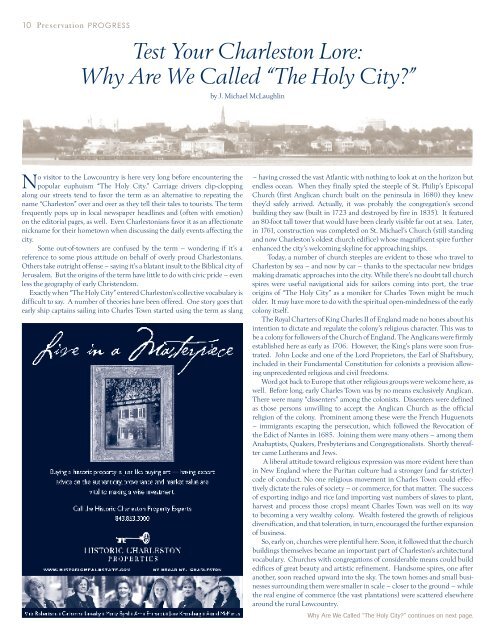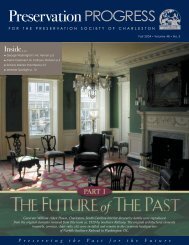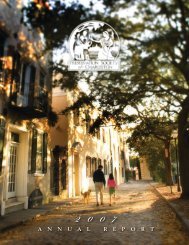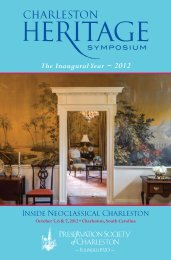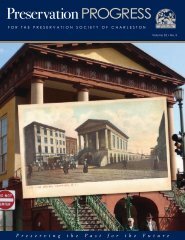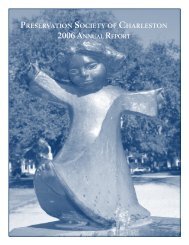download pdf - Preservation Society of Charleston
download pdf - Preservation Society of Charleston
download pdf - Preservation Society of Charleston
- No tags were found...
Create successful ePaper yourself
Turn your PDF publications into a flip-book with our unique Google optimized e-Paper software.
10 <strong>Preservation</strong> PROGRESS<br />
Test Your <strong>Charleston</strong> Lore:<br />
Why Are We Called “The Holy City”<br />
by J. Michael McLaughlin<br />
No visitor to the Lowcountry is here very long before encountering the<br />
popular euphuism “The Holy City.” Carriage drivers clip-clopping<br />
along our streets tend to favor the term as an alternative to repeating the<br />
name “<strong>Charleston</strong>” over and over as they tell their tales to tourists. The term<br />
frequently pops up in local newspaper headlines and (<strong>of</strong>ten with emotion)<br />
on the editorial pages, as well. Even <strong>Charleston</strong>ians favor it as an affectionate<br />
nickname for their hometown when discussing the daily events affecting the<br />
city.<br />
Some out-<strong>of</strong>-towners are confused by the term – wondering if it’s a<br />
reference to some pious attitude on behalf <strong>of</strong> overly proud <strong>Charleston</strong>ians.<br />
Others take outright <strong>of</strong>fense – saying it’s a blatant insult to the Biblical city <strong>of</strong><br />
Jerusalem. But the origins <strong>of</strong> the term have little to do with civic pride – even<br />
less the geography <strong>of</strong> early Christendom.<br />
Exactly when “The Holy City” entered <strong>Charleston</strong>’s collective vocabulary is<br />
difficult to say. A number <strong>of</strong> theories have been <strong>of</strong>fered. One story goes that<br />
early ship captains sailing into Charles Town started using the term as slang<br />
– having crossed the vast Atlantic with nothing to look at on the horizon but<br />
endless ocean. When they finally spied the steeple <strong>of</strong> St. Philip’s Episcopal<br />
Church (first Anglican church built on the peninsula in 1680) they knew<br />
they’d safely arrived. Actually, it was probably the congregation’s second<br />
building they saw (built in 1723 and destroyed by fire in 1835). It featured<br />
an 80-foot tall tower that would have been clearly visible far out at sea. Later,<br />
in 1761, construction was completed on St. Michael’s Church (still standing<br />
and now <strong>Charleston</strong>’s oldest church edifice) whose magnificent spire further<br />
enhanced the city’s welcoming skyline for approaching ships.<br />
Today, a number <strong>of</strong> church steeples are evident to those who travel to<br />
<strong>Charleston</strong> by sea – and now by car – thanks to the spectacular new bridges<br />
making dramatic approaches into the city. While there’s no doubt tall church<br />
spires were useful navigational aids for sailors coming into port, the true<br />
origins <strong>of</strong> “The Holy City” as a moniker for Charles Town might be much<br />
older. It may have more to do with the spiritual open-mindedness <strong>of</strong> the early<br />
colony itself.<br />
The Royal Charters <strong>of</strong> King Charles II <strong>of</strong> England made no bones about his<br />
intention to dictate and regulate the colony’s religious character. This was to<br />
be a colony for followers <strong>of</strong> the Church <strong>of</strong> England. The Anglicans were firmly<br />
established here as early as 1706. However, the King’s plans were soon frustrated.<br />
John Locke and one <strong>of</strong> the Lord Proprietors, the Earl <strong>of</strong> Shaftsbury,<br />
included in their Fundamental Constitution for colonists a provision allowing<br />
unprecedented religious and civil freedoms.<br />
Word got back to Europe that other religious groups were welcome here, as<br />
well. Before long, early Charles Town was by no means exclusively Anglican.<br />
There were many “dissenters” among the colonists. Dissenters were defined<br />
as those persons unwilling to accept the Anglican Church as the <strong>of</strong>ficial<br />
religion <strong>of</strong> the colony. Prominent among these were the French Huguenots<br />
– immigrants escaping the persecution, which followed the Revocation <strong>of</strong><br />
the Edict <strong>of</strong> Nantes in 1685. Joining them were many others – among them<br />
Anabaptists, Quakers, Presbyterians and Congregationalists. Shortly thereafter<br />
came Lutherans and Jews.<br />
A liberal attitude toward religious expression was more evident here than<br />
in New England where the Puritan culture had a stronger (and far stricter)<br />
code <strong>of</strong> conduct. No one religious movement in Charles Town could effectively<br />
dictate the rules <strong>of</strong> society – or commerce, for that matter. The success<br />
<strong>of</strong> exporting indigo and rice (and importing vast numbers <strong>of</strong> slaves to plant,<br />
harvest and process those crops) meant Charles Town was well on its way<br />
to becoming a very wealthy colony. Wealth fostered the growth <strong>of</strong> religious<br />
diversification, and that toleration, in turn, encouraged the further expansion<br />
<strong>of</strong> business.<br />
So, early on, churches were plentiful here. Soon, it followed that the church<br />
buildings themselves became an important part <strong>of</strong> <strong>Charleston</strong>’s architectural<br />
vocabulary. Churches with congregations <strong>of</strong> considerable means could build<br />
edifices <strong>of</strong> great beauty and artistic refinement. Handsome spires, one after<br />
another, soon reached upward into the sky. The town homes and small businesses<br />
surrounding them were smaller in scale – closer to the ground – while<br />
the real engine <strong>of</strong> commerce (the vast plantations) were scattered elsewhere<br />
around the rural Lowcountry.<br />
Why Are We Called “The Holy City” continues on next page.


